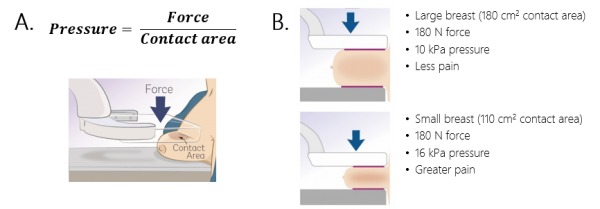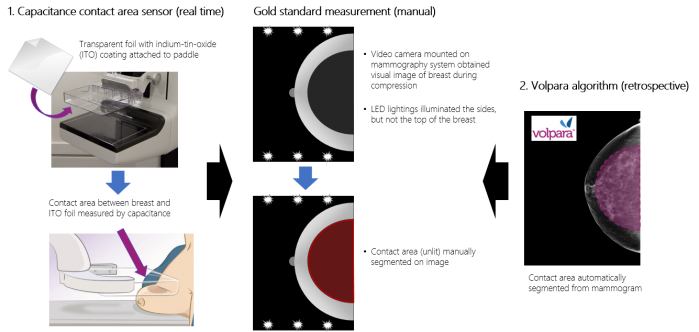Good breast compression is integral during mammography. Sufficient compression is needed to separate internal breast structures, minimize patient motion and reduce the thickness of the breast (thus increasing image contrast and reducing the radiation required to penetrate the breast). However, too much compression can be painful. Compression pressure, rather than force, may be a preferable measurement, as it accounts for variation in breast size and helps to control pain:

However, compression estimates can only be as good as the constituent metrics. Woutjan Branderhorst and researchers from the Netherlands sought to evaluate two different methods of measuring the contact area between the breast and the compression paddle—a real-time method based on breast capacitance, and a retrospective method that used Volpara’s automated segmentation of the breast. Both methods were compared to a gold standard, based on manual segmentation of the contact area, to see which was a better match:

All three measures were applied to 300 images: 148 craniocaudal projections, and 152 medio-lateral oblique projections. There were no significant differences in the mean average contact area measured by all three methods. Furthermore, both the capacitance method and Volpara had extremely high correlation to the gold standard (r = 0.989 and r = 0.965 respectively). These results demonstrate that both methods are robust and fairly accurate.
Bland-Altman analysis showed that Volpara exhibited no systematic differences from the gold standard, while the capacitance method tended to slightly under-estimate the contact area in larger breast sizes. Finally, the standard deviations of the contact area differences of each measurement method from the gold standard was 5.5% for the capacitance method and 8% for Volpara. In comparison, the standard deviations from seen in compression pressure in typical screening practice can reach over 50%; therefore, the variation introduced by the measurement of the contact area is fairly minute in comparison.
The conclusion is that both methods are accurate and precise for measuring contact area. The capacitance method can produce real-time feedback on the compression pressure experienced by women during screening, but requires specialized equipment. Alternately, Volpara can be used to retrospectively calculate compression pressure from any raw image, if the compression force is provided in the DICOM header.
